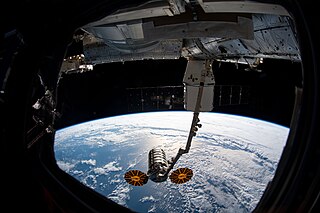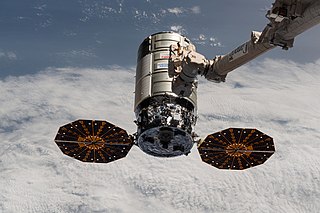
A CubeSat is a class of small satellite with a form factor of 10 cm (3.9 in) cubes. CubeSats have a mass of no more than 2 kg (4.4 lb) per unit, and often use commercial off-the-shelf (COTS) components for their electronics and structure. CubeSats are deployed into orbit from the International Space Station, or launched as secondary payloads on a launch vehicle. As of December 2023, more than 2,300 CubeSats have been launched.
The Space Test Program (STP) is the primary provider of spaceflight for the United States Department of Defense (DoD) space science and technology community. STP is managed by a group within the Advanced Systems and Development Directorate, a directorate of the Space and Missile Systems Center of the United States Space Force. STP provides spaceflight via the International Space Station (ISS), piggybacks, secondary payloads and dedicated launch services.
Technology Education Satellite (TechEdSat) is a successful nano-sat flight series conducted from the NASA Ames Research Center in collaboration with numerous universities. While one of the principal aims has been to introduce young professionals and university students to the practical realm of developing space flight hardware, considerable innovations have been introduced. In addition, this evolving flight platform has tested concepts for Low Earth Orbit (LEO) sample return, as well as planetary nano-sat class mission concepts.

Orbital-1, also known as Orb-1, was the second flight of the Orbital Sciences Cygnus cargo spacecraft, its second flight to the International Space Station (ISS) and the third launch of the company's Antares launch vehicle. The mission launched on 9 January 2014 at 18:07:05 UTC.

Nanoracks LLC is a private in-space services company which builds space hardware and in-space repurposing tools. The company also facilitates experiments and launches of CubeSats to Low Earth Orbit.

Antares A-ONE mission was the maiden flight of Orbital Sciences Corporation' Antares launch vehicle including the ascent to space and accurate delivery of a simulated payload, the Cygnus Mass Simulator (CMS), which was launched 21 April 2013. It was launched from Pad 0A at the Mid-Atlantic Regional Spaceport (MARS), Wallops Flight Facility, Virginia. The simulated payload simulates the mass of the Cygnus cargo spacecraft. This dummy payload was sent into an orbit of 223 km × 237 km with an orbital inclination of 51.63°, the same launch profile it will use for Orbital's Cygnus cargo supply missions to the International Space Station (ISS) for NASA.

OA-4, previously known as Orbital-4, was the fourth successful flight of the Orbital ATK uncrewed resupply spacecraft Cygnus and its third flight to the International Space Station (ISS) under the Commercial Resupply Services (CRS-1) contract with NASA. With the Antares launch vehicle undergoing a redesign following its failure during the Orb-3 launch, OA-4 was launched by an Atlas V launch vehicle. Following three launch delays due to inclement weather beginning on 3 December 2015, OA-4 was launched at 21:44:57 UTC on 6 December 2015. With a liftoff weight of 7,492 kg (16,517 lb), OA-4 became the heaviest payload ever launched on an Atlas V. The spacecraft rendezvoused with and was berthed to the ISS on 9 December 2015. It was released on 19 February 2016 after 72 days at the International Space Station. Deorbit occurred on 20 February 2016 at approximately 16:00 UTC.

OA-5, previously known as Orbital-5, was the seventh planned flight of the Orbital Sciences' uncrewed resupply spacecraft Cygnus and its sixth flight to the International Space Station under the Commercial Resupply Services contract with NASA. The mission launched on 17 October 2016 at 23:45:36 UTC. Orbital Sciences and NASA jointly developed a new space transportation system to provide commercial cargo resupply services to the International Space Station (ISS). Under the Commercial Orbital Transportation System (COTS) program, Orbital designed and built Antares, a medium-class launch vehicle; Cygnus, an advanced maneuvering spacecraft; and a Pressurized Cargo Module which is provided by Orbital's industrial partner Thales Alenia Space.

The Nanoracks CubeSat Deployer (NRCSD) is a device to deploy CubeSats into orbit from the International Space Station (ISS).

OA-7, previously known as Orbital-7, is the eighth flight of the Orbital ATK uncrewed resupply spacecraft Cygnus and its seventh flight to the International Space Station (ISS) under the Commercial Resupply Services contract with NASA. The mission launched on 18 April 2017 at 15:11:26 UTC. Orbital and NASA jointly developed a new space transportation system to provide commercial cargo resupply services to the International Space Station (ISS). Under the Commercial Orbital Transportation Services (COTS) program, then Orbital Sciences designed and built Antares, a medium-class launch vehicle; Cygnus, an advanced maneuvering spacecraft, and a Pressurized Cargo Module which is provided by Orbital's industrial partner Thales Alenia Space.

OA-9E was the tenth flight of the Cygnus, an uncrewed resupply spacecraft. The flight was launched by Orbital ATK (OA), which was purchased by Northrop Grumman during the mission. It was the ninth flight under the Commercial Resupply Services (CRS) contract with NASA and conducted under an extension, leading to the "E" in the mission name. The mission launched on 21 May 2018 at 08:44:06 UTC.

The Miniature X-ray Solar Spectrometer (MinXSS) CubeSat was the first launched National Aeronautics and Space Administration Science Mission Directorate CubeSat with a science mission. It was designed, built, and operated primarily by students at the University of Colorado Boulder with professional mentorship and involvement from professors, scientists, and engineers in the Aerospace Engineering Sciences department and the Laboratory for Atmospheric and Space Physics, as well as Southwest Research Institute, NASA Goddard Space Flight Center, and the National Center for Atmospheric Research's High Altitude Observatory. The mission principal investigator is Dr. Thomas N. Woods and co-investigators are Dr. Amir Caspi, Dr. Phil Chamberlin, Dr. Andrew Jones, Rick Kohnert, Professor Xinlin Li, Professor Scott Palo, and Dr. Stanley Solomon. The student lead was Dr. James Paul Mason, who has since become a Co-I for the second flight model of MinXSS.

NG-11, previously known as OA-11, is the twelfth flight of the Northrop Grumman robotic resupply spacecraft Cygnus and its eleventh flight to the International Space Station under the Commercial Resupply Services (CRS-1) contract with NASA. The mission launched on 17 April 2019 at 20:46:07 UTC. This is the last mission from the extended CRS-1 contract; follow-up missions are part of the CRS-2 contract. Cygnus NG-11 was also the first mission to load critical hardware onto Cygnus within the last 24 hours prior to launch, a new Antares feature.

RaInCube, also stylized as RainCube, was a 6U CubeSat made by NASA as an experimental satellite. It had a small radar and an antenna. It was put into orbit in May 2018 and was deployed from the International Space Station on June 25, 2018. It re-entered Earth's atmosphere and burned up on Dec. 24, 2020. It was used to track large storms.

IceCube, also known as Earth-1, was a 3U CubeSat satellite funded and developed by NASA. Its goal was to demonstrate and map ice clouds through the use of its 883 GHz radiometer.

NG-14, previously known as OA-14, was the fifteenth flight of the Northrop Grumman robotic resupply spacecraft Cygnus and its fourteenth flight to the International Space Station under the Commercial Resupply Services (CRS-1) contract with NASA. The mission was launched on 3 October 2020, at 01:16:14 UTC.

Cygnus NG-15, previously known as OA-15, was the fifteenth launch of the Northrop Grumman robotic resupply spacecraft Cygnus and its fourteenth flight to the International Space Station (ISS) under the Commercial Resupply Services (CRS) contract with NASA. The mission launched on 20 February 2021 at 17:36:50 UTC. This is the fourth launch of Cygnus under the CRS-2 contract.
Cosmic X-ray Background Nanosatellite (CXBN) was a satellite and mission developed by the Morehead State University. Unlike its successor, it was a partial failure as its transmissions were too weak for its mission due to it going into an anomalous low power mode. It was supposed to take measurements of the cosmic X-ray background in the 30-50 keV range and temporarily supplement NASA's Radiation Belt Storm Probes.

GASPACS was a NASA sponsored 1U CubeSat developed entirely by undergraduate members of Utah State University's Get Away Special (GAS) team. The primary mission objective of GASPACS was to deploy a 1-meter inflatable aerodynamic boom to passively stabilize its attitude. GASPACS was the world's first CubeSat to be developed entirely by undergraduate students, and was also the world's first CubeSat to utilize a Raspberry Pi Zero as its flight computer.

















